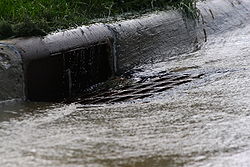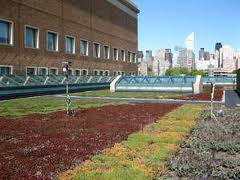A common problem in many urban areas, such as New York City, is the overflow of the city's sewer systems due to storm water runoff. Compared to rural areas, where most of the rainwater can easily percolate raw and uncovered earth to return to groundwater aquifers, cities often encounter the issue of flooding and excess runoff due to an enormous amount of paved areas, leaving little room for the absorption of rain and other runoffs into the ground. This flooding is normally controlled by storm drains and sewage systems.

(image courtesy of Wikipedia)
New York City, like other older cities, has a duel sewer system that transports both storm and waste waters. As a result, the sewage system frequently reaches capacity during the rainy seasons, such as spring and winter, and excesses must be discharged into waterways such as NY Harbor, the East River, and the Hudson. However, often this discharged wastewater is untreated, therefore causing increased amounts of physical and chemical pollution into the rivers.
Now introduce innovation. As a prototypical experiment, the company Con Edison and researchers at Columbia University teamed up in 2008 to create one of the first "green roofs" as a solution to NYC's runoff problem. On the quarter-acre roof of the Con Edison Learning Center sit 21,000 plants which have the capacity to absorb up to 30% of the rainwater that falls onto them. The plan is to create an "escape route" for the excess rainwater, providing easy evaporation back into the atmosphere through these plants, while also increasing oxygen levels in the nearby areas.
(video courtesy of ConEdisonNY)
 The study, after measuring the amount of sunlight the roof was exposed to and the amounts of energy leaving the roof, concluded that it would cost as little as two cents a year per gallon of water captured. These costs would be accounted for in the cost of the building plus maintenance of such a garden.
The study, after measuring the amount of sunlight the roof was exposed to and the amounts of energy leaving the roof, concluded that it would cost as little as two cents a year per gallon of water captured. These costs would be accounted for in the cost of the building plus maintenance of such a garden.
(image courtesy of EarthSky)
In addition, in similarly installed green-roof systems, the team has seen significantly higher retention rates, signaling the possibility of an increase of the total obviated runoff than reported in this specific study.
Built as a modular system, the green-roof design has the significant advantages, including potential self-installation by a building or residence owner, compared to built-up systems of the same nature that are less mobile.
"When we built our green roof, we were confident that researchers from Columbia would gain important knowledge about protecting the environment. Three years later, it’s clear that our project has helped us understand how roofs can save energy, cool the atmosphere, and prevent storm water runoff."
-Saddie Smith, Vice President at Con Edison.
According to the study led by Stuart Gaffin at Columbia's Center for Climate Systems Research, if every one of New York City's rooftops were equipped with this green system, it would prevent over 10 billion gallons of storm water from entering NYC's sewer system, drastically decreasing emergency usage of discharge into the state's waterways and providing a possible solution for NYC's overwhelmed sewage systems.
Article in ScienceDaily
This article is only an example of the innovative solutions discovered daily by researchers at centers such as Columbia University. If you are interested looking into the latest science supplies in your field, or if you are a laboratory supplier looking for networking opportunities with university researchers, attend Biotechnology Calendar, Inc.'s Bioresearch Product Faire™ tradeshow at the Columbia University on October 18th, 2011.
For more information about this event, click the button below:


